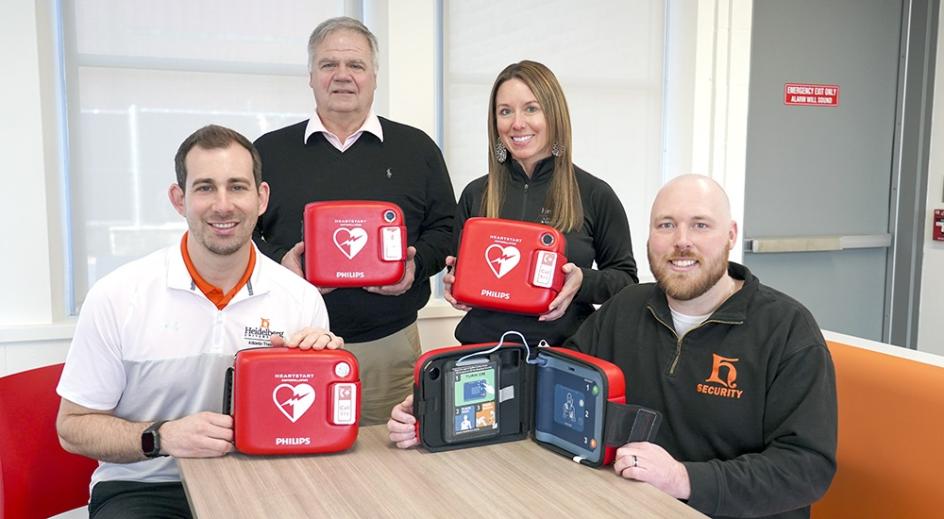
Heidelberg alumni Dr. Ernest Estep and his wife, Bonnie, both Class of ’63, have provided Heidelberg with a critical gift that they hope never has to be used. But if it does, it just could prove life-saving.

Ernie, a former member of Heidelberg’s Board of Trustees, and Bonnie have provided the funding for the university to purchase 35 AED units – short for automated external defibrillators – to be placed at key locations on campus, especially residence halls.
AEDs are portable, life-saving devices designed to treat people experiencing sudden cardiac arrest, a medical condition in which the heart stops beating suddenly and unexpectedly. The combination of CPR and early defibrillation is effective in saving lives when used in the first few minutes following a collapse from sudden cardiac arrest.
According to the U.S. Occupational Safety & Health Administration, there are about 10,000 cardiac arrests in the workplace each year in the United States. The American Heart Association says that 16.3 percent of out-of-hospital cardiac arrests occur in public settings. But less than half (40 percent) of those individuals get the immediate help they need before professional help arrives, and only 50 percent of people can locate an AED at work.
With the arrival of the new AEDs at Heidelberg, those statistics should increase dramatically
The impetus for the Esteps’ gift was three-fold. Several years ago, while at Heidelberg celebrating Alumni Weekend, Dr. Estep was called to assist an alumnus who was experiencing a cardiac incident. Then, in January, the world watched in fear as Buffalo Bills safety Damar Hamlin collapsed during an NFL game and had to be resuscitated on the field. Quick response by trainers and immediate access to AEDs quite literally saved his life.
Essentially, the Esteps recognized a need and stepped up to fill it. Ernie recalls the issue being discussed a few years ago at a Board of Trustees meeting, just prior to COVID. And then, the incident in the NFL “got me thinking, ‘What about Heidelberg?’” he said.
Time is of the essence
After inquiring about Heidelberg’s AED supply, Ernie got to work, contacting a good friend – Jon Warnock, director of business development at One Beat Medical – who’s quite in tune with AEDs, to see how he and Bonnie could help Heidelberg.
“I just want Heidelberg to be prepared,” Ernie said, “in all the classrooms, residence halls and athletic fields.”
“For every minute after a sudden cardiac arrest, the survival rate drops 10 percent. It’s very critical to get the heart beating again. Five or 10 minutes is too long.”
The American Heart Association backs this up. “If performed immediately CPR can double or triple the chance of survival from an out-of-hospital cardiac arrest,” according to the AHA website.
Janelle Baldosser, director of the Stoner Health & Counseling Center, also recognizes the need for quick action and access to the correct equipment. “We need AEDs readily available at the first sign of a cardiac event – because they save lives,” she said.
Prior to the Esteps’ gift, Heidelberg had 12 AED units – eight spread in various buildings and four for use by athletic trainers for practices and games. After installation is complete, Heidelberg’s inventory of AEDs will jump to 47.
Jake McGraw, Director of Safety & Security – working alongside Rod Morrison, Associate Vice President for Facilities & Engineering, and Bob Fruth, the Chemical/Lab Operations Specialist – mapped the campus to determine the most effective locations for the new AED units.
Part of the awareness campaign will be to install new signage to indicate where the AEDs are located, Jake said.
But the biggest addition will be in the residence halls. “We want to make sure all of the dorms have them and the staff are trained so that RAs will have the knowledge they need,” Jake said. The training will allow the RAs to become CPR- and AED-certified.
Once installed, Security will conduct monthly checks on all of the AED units, ensuring batteries, keypads and all functionality is in good working order, and the Security team will keep records of that data.
Training is key
Awareness and training will be a key component in potentially saving lives.
“We know the importance of getting students, faculty and staff trained, and we’re working with the manufacturer on training opportunities on campus,” said Janelle, who’s also a Basic Life Support and Advanced Cardiac Life Support instructor.
Janelle and Tyson Depinet, head athletic trainer for football, men’s basketball, golf and cheer, said users should understand that the units are extremely user-friendly.
“As soon as you open one up, it gives you detailed voice and visual instructions that walk you through how to use the devices,” Tyson explained. “You don’t have to be a healthcare provider to use them.”
In the event of a cardiac incident, access to an AED is key, according to Tyson, who also is an instructor of health science. “It’s all about proximity and response time and getting an individual connected to an AED,” he said. “Ninety seconds to two minutes is the window.”
AEDs are programmmed so the individual using them cannot do any harm to the person who’s having a cardiac event. “It’s really important that people not be afraid to use these units,” Ernie said.
Additional training is being planned for resident assistants this summer as well as staff and faculty.
All of this is encouraging news to Ernie, whose greatest hope is that the entire campus takes advantage of training and becomes aware of the locations of the AEDs.
“I’m really hopeful people on campus will get trained and know where the AEDs are located,” he said. “I hope they never have to be used, but they do have the potential to save lives.”
As of the beginning of March, all of the new AEDs have arrived. Installation will take place through the spring semester and be completed by Alumni Weekend.